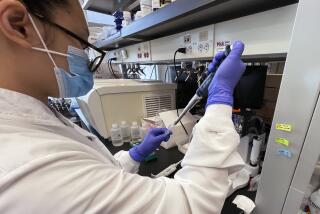Like Taking a Temperature : Fish’s Cough Tests Water for Scientists
- Share via
DULUTH, Minn. — If a fish doesn’t cough when released in a water sample at the nation’s largest center for freshwater research, scientists figure the water quality is pretty good, said aquatic biologist Robert Drummond.
“It’s sort of like taking the temperature of a human,” Drummond explained. “For fish, a cough is a natural gill-clearing response to get rid of pollutants. They cough in direct proportion to the toxicant.”
The U.S. Environmental Research Laboratory in this Lake Superior city is the federal Environmental Protection Agency’s main center for studying freshwater toxicology. For 20 years, researchers have been determining what concentrations of pesticides, toxic substances and hazardous wastes are harmful to freshwater aquatic life.
Substance Bans
The center’s work has led to bans on polychlorinated biphenyls, DDT and other pollutants.
“Our main product out of this lab is published reports,” Drummond said. “We can do all kinds of wonderful tests, but if we don’t share it, it doesn’t do any good.”
The laboratory was founded by Congress in 1967 as the National Water Quality Laboratory to develop quality standards for the nation’s fresh waters.
“At that time many of the nation’s waters were in terrible shape,” said Dr. Gilman D. Veith, who was named the third director of the Duluth laboratory this year.
Small Start
The lab started with 31 employees and a budget of $545,000. In 1970, when the EPA was formed, the laboratory became part of the agency. The annual budget reached $9.4 million this year, supporting the research of 120 EPA employees, about 100 university and contract specialists.
“We were instrumental in banning PCBs and DDT,” Veith said. “The research that was done to show that these were such dangerous contaminants, that they were building up in fish in rivers and lakes, was done here.”
Research on dioxins involving 2,000 fish samples from throughout the United States was done recently at the EPA’s National Dioxin Monitoring Laboratory, part of the Duluth facility.
Perhaps the biggest surprise from that study, said contract researcher Brian Butterworth, was the finding of dioxins in fish from test sites downstream from pulp and paper mills.
Pipe Permits
Veith noted that every pipe in the country discharging material into a natural body of water must have a permit. Permits vary, allowing only specified materials to be discharged, and the EPA’s regional offices are responsible for determining the content of discharges. “We do research to tell what kind of permits should be issued so they don’t pollute the water.”
Lake Erie began to grow cleaner, Veith said, after a waste contamination law was implemented several years ago--a law based on research done at the laboratory. “A lake they thought was dead is now very much alive. It was not dead, it was just very much abused,” Veith said.
The researchers don’t attempt to perform the cleanup themselves. “We’ve told the states what needs to be done, and industry is responding,” Veith said.
Report, Not Interpret
However, the laboratory does not make public health statements.
“We generally report what is there and how much. We do not interpret those results. That is up to health authorities, regarding human health. If we are asked, ‘Will it hurt fish?’ we can answer that,” Veith said.
For the research, the Duluth laboratory hatches 1,000 fish every day. At any one time, 20,000 fish, most of them fathead minnows, are being used to determine the effect of more than 100 toxic chemicals and other substances on freshwater organisms.
More to Read
Sign up for Essential California
The most important California stories and recommendations in your inbox every morning.
You may occasionally receive promotional content from the Los Angeles Times.













